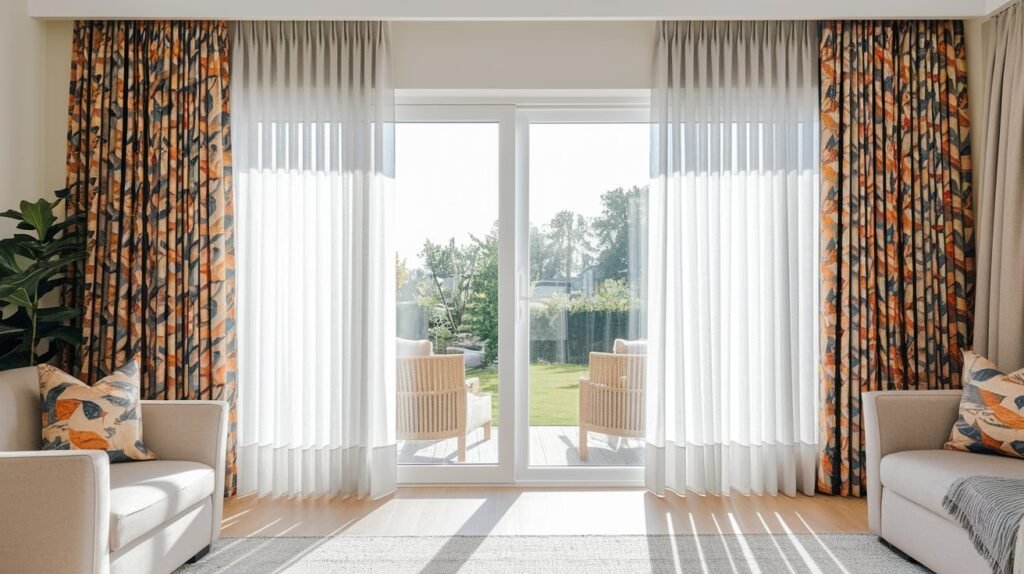Looking to give your sliding glass doors a fresh new look?
You’re in the right place! Sliding glass doors are fantastic for bringing natural light into your home, but they can feel a bit bare without the right window treatments. That’s where smart “curtains for sliding glass doors ideas come into play.
Finding window treatments that don’t interfere with door functionality while still looking fabulous.
Creative curtain options that blend style with practicality.
A space that feels complete, cozy, and uniquely yours.
From flowing sheer panels that dance in the breeze to bold patterns that command attention, there are countless ways to dress up those glass doors.
Ready to see how the right curtains can completely change your room’s vibe? Let’s jump into some inspiring options that work in real homes.
Choosing the Right Curtains for Sliding Glass Doors
Getting the perfect curtains for your sliding glass doors isn’t just about picking something pretty.
You need to think about how they’ll function with your doors, complement your space, and meet your privacy needs. Let’s break down the key factors that’ll help you make the best choice.
Fabric Types: Sheers, Blackout, Linen, and More
The fabric you choose sets the tone for your entire room and determines how much light and privacy you’ll get.
- Sheer Fabrics offer the perfect balance when you want to maintain your view while adding softness to the space. They filter harsh sunlight beautifully while still letting you see outside. Perfect for living rooms where you want that airy, open feel.
- Blackout Curtains are your best friend for bedrooms or media rooms. They block out light completely and provide maximum privacy. Look for thermal-backed options that also help with energy efficiency.
- Linen brings a natural texture and works well in casual, relaxed spaces. It’s breathable and has that lived-in look that’s so popular right now. Just keep in mind that linen wrinkles easily.
- Cotton Blends give you durability and easy care. They come in countless colors and patterns, making them versatile for any decorating style.
- Velvet adds luxury and drama while providing excellent light control. It’s heavier, so make sure your rod system can handle the weight.
Curtain Length and Width Tips for Sliding Doors
Getting the measurements right makes all the difference between amateur and professional-looking results.
Length Options:
- Floor-length is the most popular choice. Aim for curtains that just kiss the floor or hover about half an inch above it
- Puddle length adds drama with fabric that pools on the floor, but it’s harder to keep clean
- Sill-length works if you have furniture beneath the doors, but it can look choppy with tall sliding doors
Width Guidelines: Your curtains should be 1.5 to 3 times the width of your door opening. More fabric creates fuller, more luxurious folds. For a modern, streamlined look, go with less fullness. For traditional or romantic styles, opt for more fabric.
Pro Tip: Always measure from where your rod will sit, not from the top of the door frame. This gives you accurate length calculations.
Curtain Rods and Track Systems That Work Best
The hardware you choose affects both function and style. Since sliding doors need to open and close frequently, your system needs to work smoothly.
- Ceiling-Mounted Tracks are fantastic for a clean, modern look. They allow curtains to stack completely off the glass when open, maximizing your view and door access.
- Wall-Mounted Rods work well when you want the hardware to be part of the design. Choose rods that extend well beyond the door frame so the curtains can stack back properly.
- Traverse Rods let you open and close curtains with a simple cord pull. This is especially helpful for heavy fabrics or hard-to-reach installations.
- Double Rod Systems allow you to layer different fabrics for maximum versatility. You might combine sheers with blackout panels for ultimate light control.
- Hardware Weight Capacity: Make sure your chosen system can support your curtains’ weight. Heavy fabrics like velvet or lined panels need sturdy support.
Matching Curtains with Interior Styles
Your curtains should feel like a natural part of your overall design scheme.
- Modern Styles work best with clean lines and minimal fuss. Think solid colors, geometric patterns, or subtle textures. Grommet-top or rod pocket styles keep things streamlined. Stick to neutrals or bold single colors rather than busy patterns.
- Boho Styles love texture, pattern, and natural materials. Macrame tiebacks, tassels, and fringe add interest. Layering different textures and incorporating warm, earthy colors fits this free-spirited vibe perfectly.
- Classic Styles call for timeless fabrics and traditional hanging methods. Pinch pleats, valances, and rich fabrics like silk or damask work beautifully. Colors tend to be more muted and sophisticated.
- Farmhouse Styles embrace natural materials like linen and cotton in neutral tones. Simple tab-top or tie-top styles fit the casual, comfortable feel. Gingham, stripes, or small floral patterns add charm without overwhelming the space.
- Coastal Styles favor light, breezy fabrics in blues, whites, and sandy beiges. Natural materials like linen or cotton work perfectly. Keep patterns simple – think stripes or subtle nautical motifs.
The key is choosing curtains that support your overall design vision while meeting your practical needs for light control, privacy, and easy door access.
DIY vs. Ready-Made Curtains: What’s Best for Sliding Glass Doors?
|
Factor |
DIY Curtains |
Ready-Made Curtains |
|
Customization Options and Fabric Choice |
||
|
Fabric Selection |
Unlimited options from any fabric store |
Limited to the manufacturer’s current collections |
|
Size Options |
Perfect custom fit for any door size |
Standard sizes may not fit perfectly |
|
Design Control |
Complete creative freedom over style, pleats, and lining |
Choose from the available designs only |
|
Color Matching |
Exact color match to existing decor |
Limited color options may require compromise |
|
Special Features |
Add pockets, ties, or unique details |
Features depend on what’s commercially available |
Cost Comparison |
||
|
Initial Investment |
$15-50 per panel (fabric + supplies) |
$25-150+ per panel, depending on quality |
|
Tools Needed |
Sewing machine, measuring tools, and an iron |
None required |
|
Long-term Value |
Higher if you make multiple sets |
Lower cost per use if buying quality pieces |
|
Fabric Quality |
Control over fabric grade and durability |
Varies widely by brand and price point |
|
Hidden Costs |
Thread, interfacing, hardware, time |
Potential alteration costs for fit |
Time and Skill Required for DIY |
||
|
Time Investment |
4-8 hours per set of panels |
1-2 hours for shopping and hanging |
|
Skill Level Needed |
Basic to intermediate sewing skills |
No special skills required |
|
Learning Curve |
May need to learn techniques for the best results |
Immediate installation possible |
|
Mistake Factor |
Errors can be costly in time and materials |
Returns are possible if unsatisfied |
|
Satisfaction Level |
High personal accomplishment |
Quick problem resolution |
Bottom Line Recommendations:
Choose DIY if: You have sewing experience, want exact specifications, enjoy crafting, or have unusual door sizes that make ready-made options difficult.
Choose Ready-Made if: You need curtains quickly, prefer guaranteed results, lack sewing skills, or want to test styles before committing to custom work.
Hybrid Approach: Buy ready-made panels and customize with DIY touches like trim, tiebacks, or hemming for perfect length.
7 Stylish Curtain Ideas for Sliding Glass Doors
1. Floor-to-Ceiling Sheer Panels
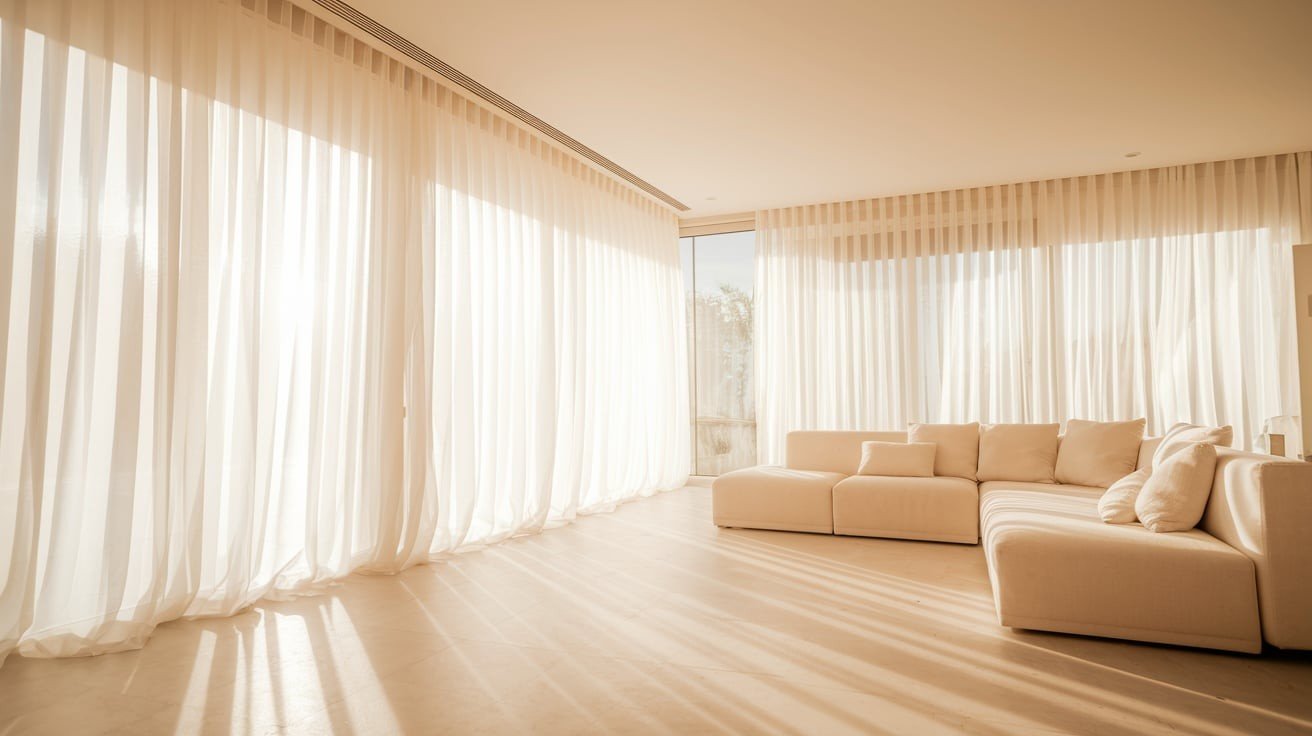
Description: Light, flowing fabric panels that extend from the ceiling to the floor, creating an airy, open feel while providing gentle light filtration.
Appeal: Creates height and drama while maintaining your outdoor view. The soft movement adds life to any space.
Best Rooms: Living rooms, dining areas, and spaces where natural light is a priority.
Functional Tips: Use ceiling-mounted tracks for seamless installation. Choose machine-washable fabrics for easy maintenance.
2. Layered Curtains (Sheer + Blackout Combo)
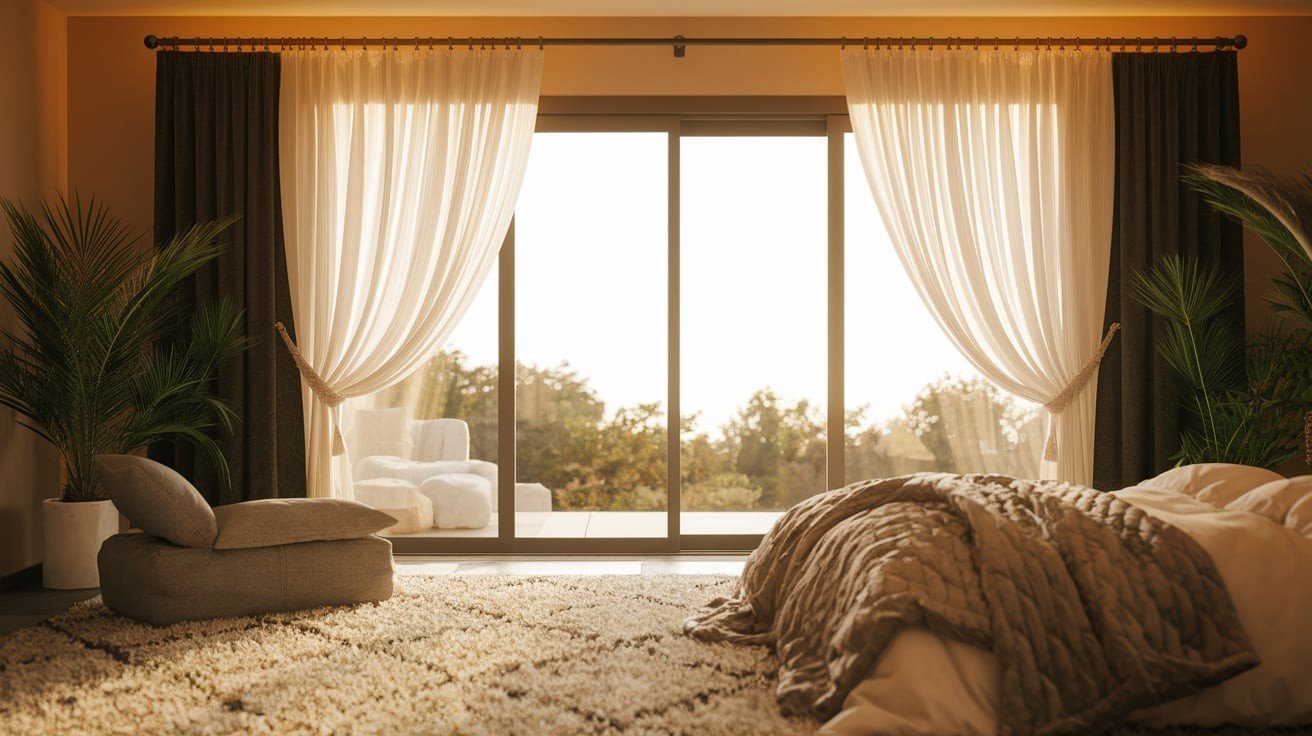
Description: Combines transparent sheers with opaque panels on a double rod system, offering maximum flexibility for light and privacy control.
Appeal: Provides versatility for different times of day and occasions. Adds depth and visual interest to windows.
Best Rooms: Bedrooms, nurseries, and multipurpose spaces needing variable light control.
Functional Tips: Install sheers closest to the glass. Choose coordinating colors that complement each other when both layers are visible.
3. Grommet-Top Curtains for a Clean, Modern Look
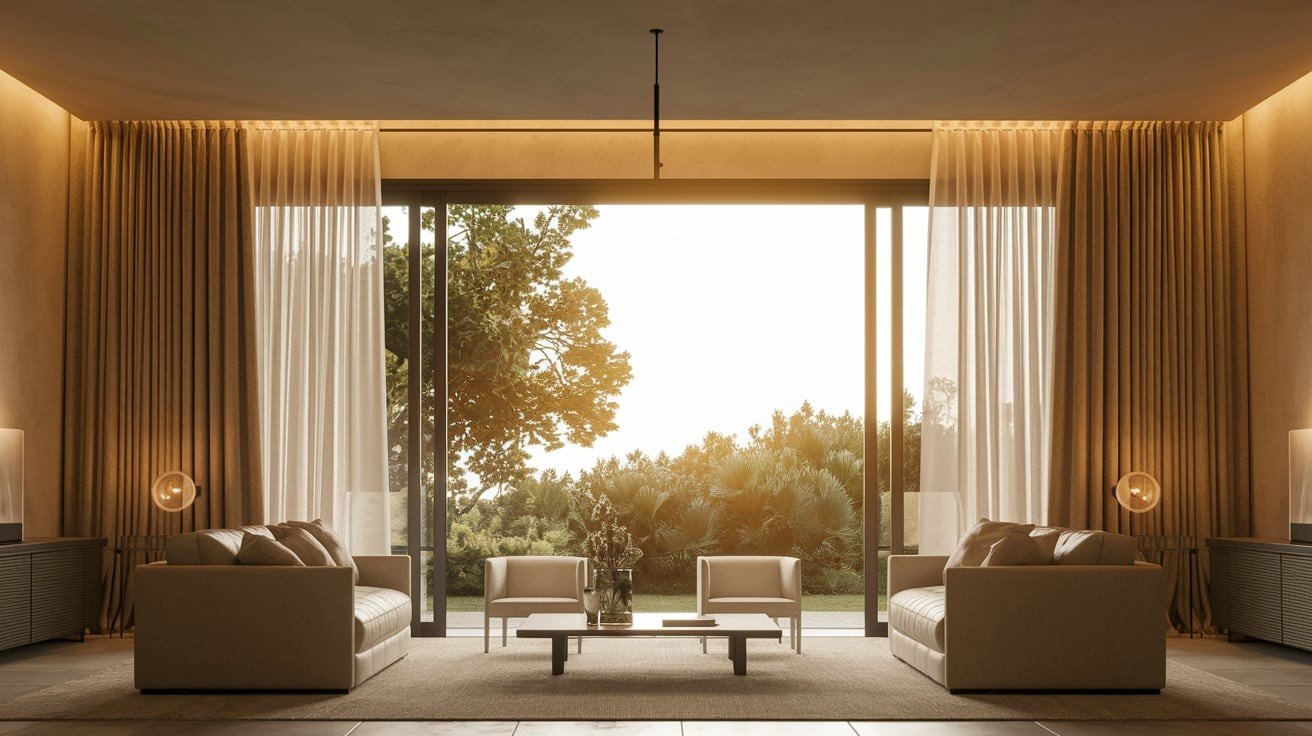
Description: Contemporary panels with metal rings sewn directly into the fabric, creating smooth, uniform folds when hung on a rod.
Appeal: Offers sleek, minimalist appearance with easy operation. Hardware becomes part of the design element.
Best Rooms: Modern living spaces, offices, and contemporary bedrooms.
Functional Tips: Ensure grommets are large enough for your rod. Choose sturdy fabric to prevent tearing around metal rings over time.
4. Tie-Back Curtains with Decorative Holdbacks
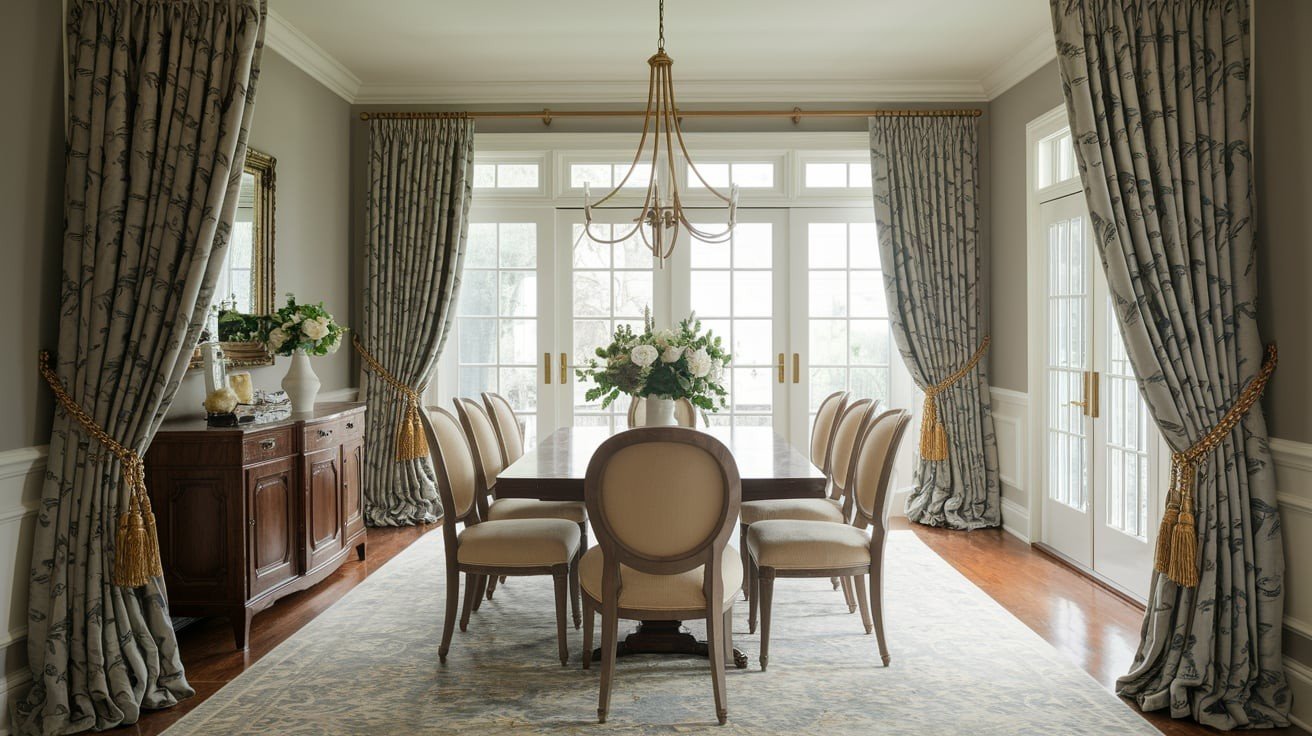
Description: Traditional panels paired with ornamental hardware that holds fabric away from the door opening when not in use.
Appeal: Combines functionality with decorative flair. Holdbacks become focal points that enhance your overall design scheme.
Best Rooms: Formal dining rooms, traditional living spaces, and bedrooms with classic decor.
Functional Tips: Position holdbacks at two-thirds the height of your curtains. Choose hardware that matches other room fixtures.
5. Bold Patterned Curtains to Make a Statement
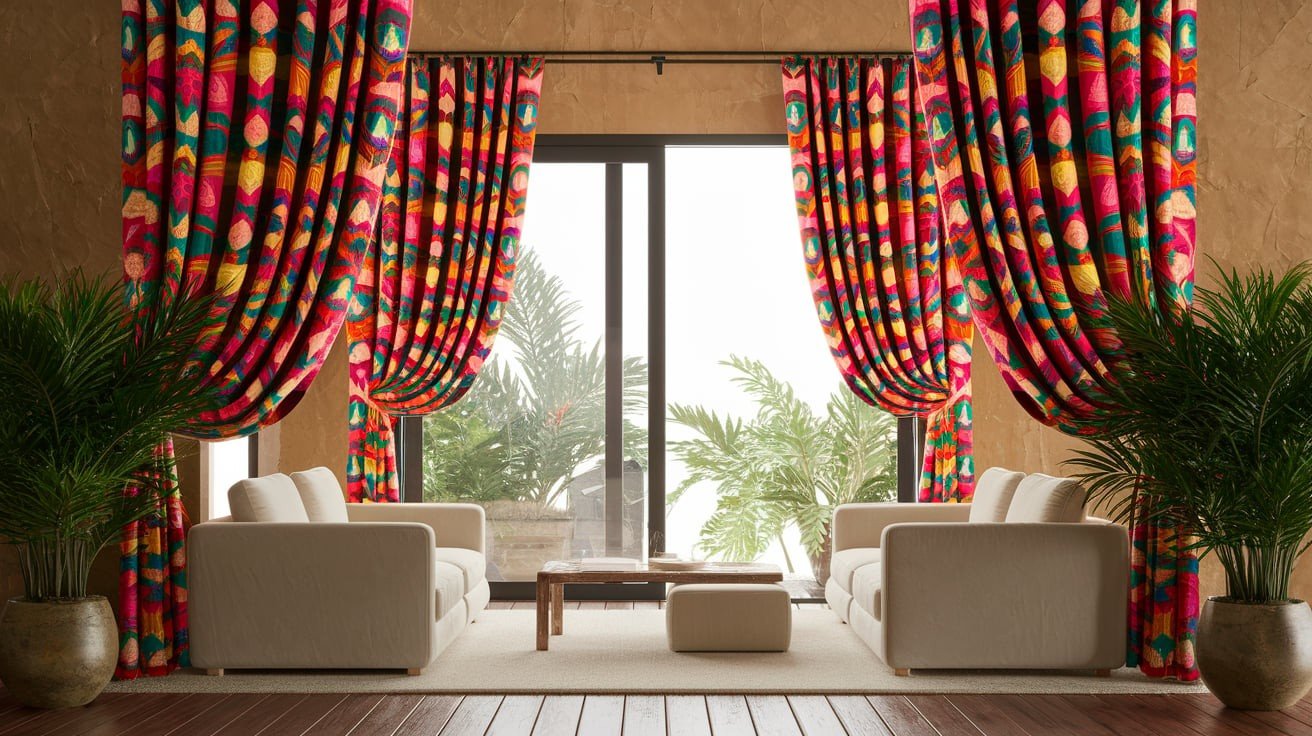
Description: Eye-catching designs featuring geometric shapes, florals, or artistic prints that serve as room focal points.
Appeal: Instantly transforms plain doors into design features. Adds personality and visual interest to neutral spaces.
Best Rooms: Living areas, home offices, and spaces that need personality injection.
Functional Tips: Balance busy patterns with solid furniture and accessories. Consider room size-large patterns work better in spacious areas.
6. Neutral Linen Panels for a Minimalist Vibe
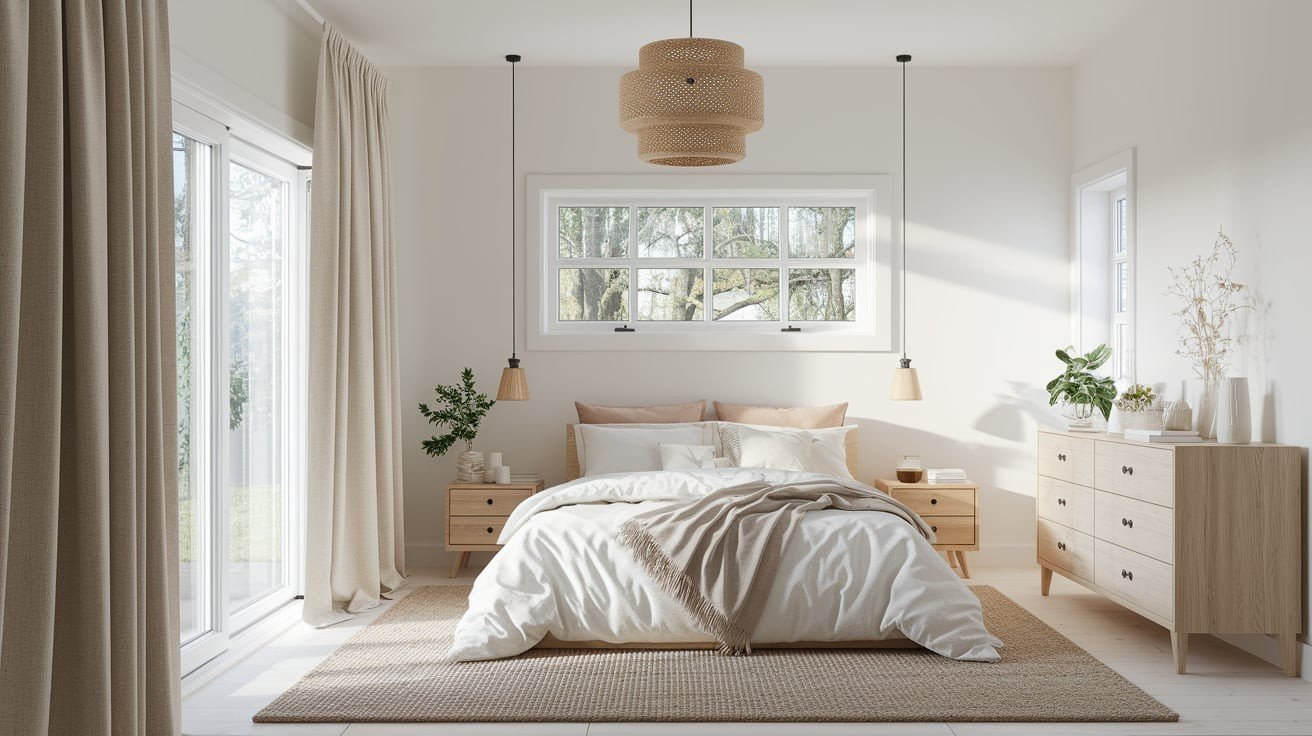
Description: Natural fiber curtains in soft, muted tones that complement rather than compete with your existing decor.
Appeal: Creates a calm, serene atmosphere while adding subtle texture. Timeless choice that works with changing decor trends.
Best Rooms: Bedrooms, meditation spaces, and Scandinavian-inspired interiors.
Functional Tips: Accept natural wrinkles as part of linen’s charm. Choose pre-shrunk options or have them professionally cleaned initially.
7. Thermal Insulated Curtains for Energy Efficiency
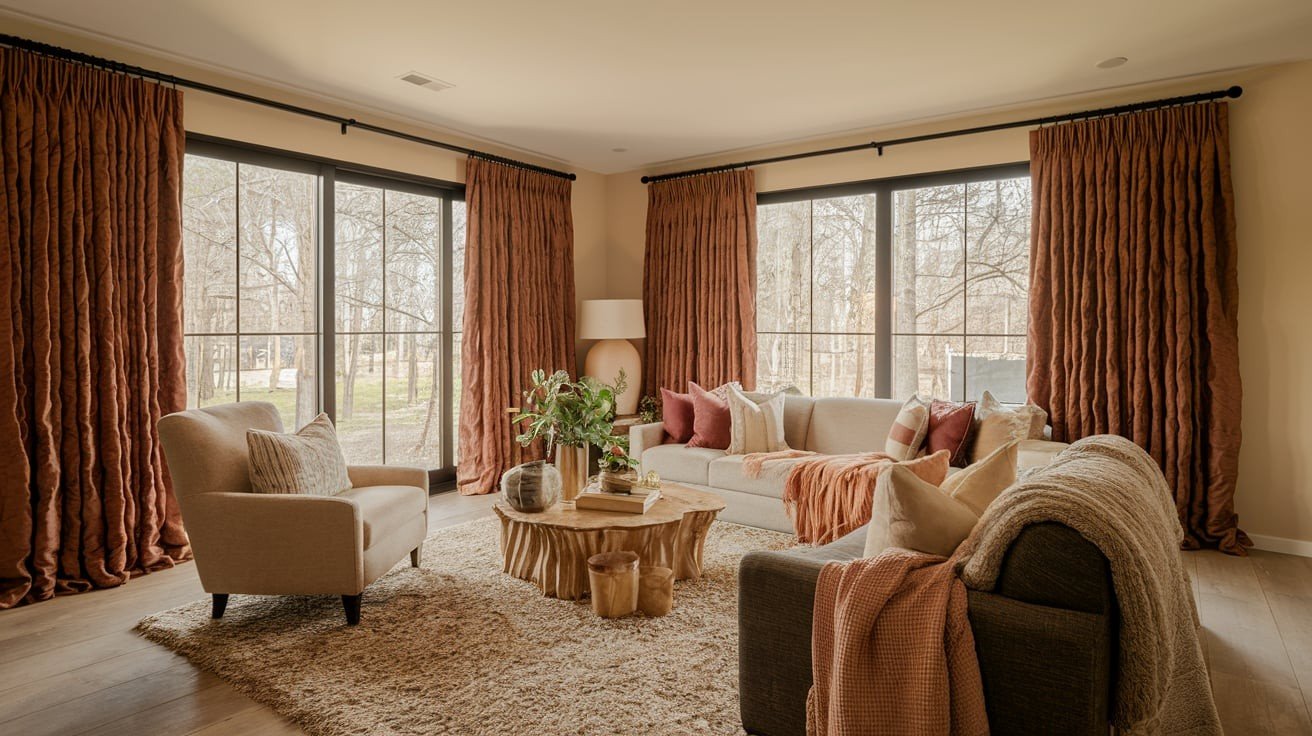
Description: Multi-layered panels with special backing designed to regulate temperature and reduce energy costs while providing style.
Appeal: Combines practical benefits with attractive appearance. Available in numerous colors and patterns to suit any decor.
Best Rooms: Bedrooms, family rooms, and any space where temperature control matters.
Functional Tips: Look for certifications indicating energy efficiency ratings. Ensure proper installation to maximize insulation benefits around door frames.
Conclusion
Finding the perfect curtains for your sliding glass doors doesn’t have to be overwhelming.
With these seven stylish options and practical tips, you’re well-equipped to make a choice that balances beauty with functionality. Remember that the best curtains for your space depend on your specific needs, whether that’s maximum light control, energy efficiency, or simply adding personality to your room.
Take time to consider your lifestyle, design preferences, and budget before making your final decision.
The right window treatments will not only enhance your doors but also improve your daily living experience. From floor-to-ceiling sheers that create drama to thermal panels that save energy costs, there’s a perfect solution waiting for your space.
Start with proper measurements, choose quality hardware, and don’t be afraid to experiment with different styles until you find your ideal match.
Frequently Asked Questions
What’s the best curtain length for sliding glass doors?
Floor-length curtains work best, hanging just above the floor or lightly touching for a polished, proportional look.
How wide should curtains be for sliding doors?
Choose curtains 1.5 to 3 times wider than your door opening for proper fullness and complete coverage.
Can I use regular curtain rods for sliding glass doors?
Yes, but ensure rods extend beyond the door frame so curtains stack back without blocking door operation.

